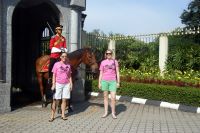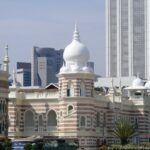I’ve just said hello (and goodbye) in Bahasa, which is the language of Malaysia (and after a fashion, of Indonesia as well). We just entered Malaysia at Padang Besar after a 17-hour trip from Bangkok on the train. We had a sleeper compartment (the seats changed to a bed) for around $33. I still remember the first time I came here—1997. I was on sabbatical, and had a ticket from a conference in Mumbai to Bangkok, and then a ticket from Singapore to Hong Kong.
The challenge was the over 1,000 miles from Bangkok to Singapore, through a country I’d barely heard about—Malaysia.
I’m as delighted to be here as I was the first time. I’m checking in from Kuala Lumpur, after two long (almost too long) train rides—from Bangkok to Penang (about 20 hours) then from Penang to Kuala Lumpur (only 9 hours, but it got in here at 5 a.m.)

I fell in love with Pulau Penang (an island that with some mainland constitutes a state in the 13-member federation of Malaysia) that time, and I’ve been back 3 times since. Nothing has dampened my ardor. I think my students were as awestruck as I am. Here are some of the reasons why:
1) our site visit graphically demonstrated the truth of Friedman’s the world is flat. We toured the Dell factory which makes 95% of the US laptops and ships them to Nashville or Reno for redistribution. They make the laptop to order within a day. I remember getting mine within a week from the time I placed the order. The Penang area has become a mecca for high tech, and perhaps that’s why Dell located there (AMD, a supplier, was there first). The work force, mostly Muslim women (around 5,500) get around 300 a month, plus overtime. The parts come from all over the world, illustrating the principle of the “disassembly line.” The result is an affordable computer, customized for each order.
2) Penang is now a UNESCO world heritage site, and I’m glad it gained that distinction because it has marvelous old colonial architecture. It’s older than Singapore, and was the first British colony in the eventual British Crown Colony (I think it was the Straits Settlements and Malaya—the old Sultans remained in power as heads of states with British advisors, the Straits Settlements, Chinese dominant, being Malacca, Penang, and Singapore). There’re wonderful old colonial hotels (Mrs. Hoyt and I stayed at the Eastern and Oriental, an 1885 gem, that was reopened in an indication of the multiple ethnicities of Malaysia); historical sites that one stumbles on. Dr. Sun Yat-sen made Penang his home in exile for about five years as he raised money trying to overthrow the Qing dynasty and establish a republic. He was the president of the Republic after 1911 and is revered in both mainland and Taiwan, no mean feat; and preserved architecture that looks like I thought Hong Kong ought to resemble—and probably did in the 1950s! I was glad to see one of the old buildings (that I’d considered buying and restoring for my 29 servants—that was one reason I did not buy it) had been saved and restored by a well-known American company—and it now is the most elegant of KFCs in the world!
3) Penang is predominantly a Chinese city in a majority Malay (Muslim) country. Penang area is around 1.5 million people, half Chinese, but Georgetown (aha now you know it was British, and the rail station is on the mainland, across from the island, and it’s called Butterworth!), but as I said, it’s a diverse mix with great ethnic foods and ethnic sites. There’s a Burmese Buddhist temple which is even more over the top in its showiness than the Thai Buddhist temple across the street. I was so impressed by the Burmese one that I was inspired to visit Burma a few years ago. Our guide called Penang a food paradise, and then proved it. We had one dinner by the ocean at a hawkers (food court) where the guide (Chinese background) ordered dish after wonderful dish of some of the best food that we had on the trip. I managed to convince him spaghetti and French fries (staples in Bangkok because we were Americans) was not the reason we’d come to Asia. As my grandson is fond of saying, “Yum yum.” Wisdom comes from 2-year-olds.
 It was difficult leaving 19th century environs. Fort Cornwallis, named after the governor of Bengal, the very same Cornwallis who lost at Yorktown and was posted in India had an encampment that paled before the reenactments we’ve gone to at Fort de Chartres (which is roughly the same period!). We went from Chinatown to the train—and not just because the train was a sleeper, but left no space for bags, and got into Kuala Lumpur (meaning muddy waters) at 5 a.m.
It was difficult leaving 19th century environs. Fort Cornwallis, named after the governor of Bengal, the very same Cornwallis who lost at Yorktown and was posted in India had an encampment that paled before the reenactments we’ve gone to at Fort de Chartres (which is roughly the same period!). We went from Chinatown to the train—and not just because the train was a sleeper, but left no space for bags, and got into Kuala Lumpur (meaning muddy waters) at 5 a.m.
Malaysia was a country that had not crossed my radar before I stumbled upon it, but it’s impressive as a predominantly Muslim country that is quite progressive. It helps that it had, for many years, an intelligent Prime Minister who was even more powerful than the Sultans. Dr. Mahathir Mohamad was determined to put Malaysia on the map as more than, “O, we’re the country close to Singapore, which you’ve heard of.” He was the one who built the Petronas Towers, which were until recently the tallest buildings in the world (now, there are tallest with antenna, tallest with hotel, etc.).
We got in and went to breakfast and I told our guide I thought most of our students would enjoy an Indian breakfast—murtabak (mutton and chicken filled pancakes, made mostly by Muslim Indians), various breads so called, made with banana or eggs, dipped in dal or sambal, nasi lemak (coconut rice) and mango lassi, along with dosa (rice-based pancakes)—I better stop writing about food! To their surprise, most of the students, and all the A students (of course) enjoyed the meal! I know I did.
Touring KL gives one a sense of the desire of Dr. Mahathir; the buildings are impressive, and in the Malay style, with specific roofs. There’s also some 
 Moorish-British architecture that’s also distinctive—in fact, some of us commented that the old train station looks more like a mosque than the National Mosque we toured. Malaysia also has a king—the nine sultans rotate the position every five years and get to live in the palace; every hour there’s a changing of the guard, including mounted soldiers; the uniforms are pretty spiffy, but it’s not the UK.
Moorish-British architecture that’s also distinctive—in fact, some of us commented that the old train station looks more like a mosque than the National Mosque we toured. Malaysia also has a king—the nine sultans rotate the position every five years and get to live in the palace; every hour there’s a changing of the guard, including mounted soldiers; the uniforms are pretty spiffy, but it’s not the UK.
One other place we toured that I thought was interesting was the memorial to soldiers, a monument designed to honor not only WWI and WWII soldiers, but also those who died in the “Emergency.” What delayed Britain’s exit from Malaysia was an ongoing civil war against Communists that resembled the American War in Viet Nam, but had a different result.
Malaysia is a secular state, but as I said, it has a Muslim majority that has ruled the country from the beginning. Our (Chinese) guide in Penang said that Muslims are tried under Muslim rule, and that if you marry a Muslim, you must convert. The government gives preferences in government jobs and in university admission to Malays. Our guide here in KL said that if you call someone a Malaysian, you mean they’re Muslim; otherwise they’re Malaysian-Chinese or Malaysian-Indian. He noted that the Chinese do well because they have been successful in business and help one another out. We saw three clan houses in Penang, and I know we’ll see some in Malacca when we get there—it’s where the “fraternity” exists by last name—in Penang there were 24th generation Chinese!
We’re meeting an IWU alum tonight, James Lai, who graduated around 1995. He’s a graphic designer, and should have interesting things to share with our students about what it’s like to live and work in KL, his home town.
Incidentally, it rains 300 days a year in KL—and, no coincidence, it’s raining right now.
I should point out for the parents reading this blog that at the Khoo family clan house in Penang (they’re the wealthiest clan), the building features prominent Confucian virtues, including one of a daughter who stays up all night to fan her parents so they can sleep. If your child does not share his or her copy with you, let me know; I have a copy which I’d be glad to share with you so that you can have proper filiopiety exhibited in your household.
Selamat datang.
